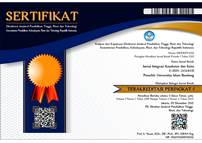Hubungan Jenis Kecelakaan dengan Tipe Fraktur pada Fraktur Tulang Panjang Ekstremitas Bawah
Abstract
Cedera diprediksi menjadi penyebab utama kematian dan kecacatan dengan fraktur sebagai trauma utama, bahkan World Health Organization (WHO) telah menetapkan tahun 2000 ̶ 2010 sebagai “The Bone and Joint Decade”. Traumatic fracture dapat terjadi pada kecelakaan lalu lintas dan non-lalu lintas. Tipe fraktur berdasar atas hubungan dengan jaringan sekitarnya, antara fragmen tulang dan dunia luar (terbuka dan tertutup) dipengaruhi oleh beberapa faktor. Penelitian ini bertujuan mengetahui hubungan jenis kecelakaan dengan tipe fraktur yang terjadi pada fraktur tulang panjang ekstremitas bawah di Rumah Sakit Khusus Bedah Halmahera tahun 2017. Penelitian ini menggunakan metode analitik melalui cross sectional dan dilaksanakan selama Februari –Juni 2018. Pengambilan sampel menggunakan teknik simple random sampling dari data sekunder, yaitu rekam medik yang telah memenuhi kriteria inklusi dan tidak termasuk eksklusi dihitung menggunakan uji dua hipotesis didapatkan 84 orang. Hasil penelitian bivariat menggunakan uji chi-square didapatkan nilai signifikansi variabel jenis kecelakaan (p<0,001) lebih kecil daripada nilai signifikansi uji (p<0.05), terdapat perbedaan proporsi kejadian fraktur terbuka antara korban kecelakaan lalu lintas dan non-lalu lintas. Simpulan bahwa pada jenis kecelakaan dan tipe fraktur terdapat hubungan yang dipengaruhi oleh mekanisme cedera, kekuatan energi, tipe benda, dan kronologis kecelakaan.
CORRELATION BETWEEN TYPE OF ACCIDENTS AND TYPE OF FRACTURES IN LOWER-EXTREMITY LONG BONE FRACTURES
Injury predicted to be a leading cause of death and disability, with fractures as the majority of trauma, even the World Health Organization (WHO) has set 2000 ̶ 2010 as “The Bone and Joint Decade”. Traumatic fractures can be caused by the road traffic accidents and non traffic accidents. Fracture types in terms of its relation to the tissues involved, between the bone fragments and the outside (open and closed fractures) can be affected by several factors. This study purposed to determine the relation between types of accidents and types of fractures occurred in Halmahera Surgery Hospital 2017. This research uses analytic method with cross sectional study and was conducted in February ̶ June 2018. Data sampling was taken by simple random sampling technique from medical records as secondary data, and the number of samples met both inclusion and exclution criteria calculated using the two hypotheses test resulted 84 people. The result of this research with chi-square test showed that the significance value of the type of accidents (p<0.001) was lesser than the test significance value (p<0.05). This concluded that in this bivariate comparation research there is a difference between the type of accidents and low extremity long bone fracture types.
Keywords
Full Text:
PDFReferences
Woolf AD. The bone and joint decade 2000-2010. Ann Rheum Dis. 2000 Feb;59(2):81–2.
Triono P, Murinto. Aplikasi pengolahan citra untuk mendeteksi fraktur tulang dengan metode deteksi tepi. J Inform. 2015;9(2):1115–23.
Storheim K, Zwart JA. Musculoskeletal disorders and the Global Burden of Disease study. Ann Rheum Dis. 2014 Jun 1;73(6):949–50.
Riset Kesehatan Dasar (Riskesdas) 2013 (diunduh 20 Agustus 2018). Tersedia dari: http://www.depkes.go.id/resources/download/general/HasilRiskesdas 2013.
Rennie L, Court-Brown CM, Mok JY, Beattie TF. The epidemiology of fractures in children. Injury. 2007;38(3):913–22.
Solomon L, Warwick D, Nayagam S. Apley’s system of orthopaedics and fractures (9th Edition). Malaysian Orthopaedic J. 2010;4(3):39.
Meling T, Harboe K, Søreide K. Incidence of traumatic long-bone fractures requiring in-hospital management: a prospective age-and gender-specific analysis of 4890 fractures. Injury. 2009;40(11):1212–9.
Gustilo RB, Mendoza RM, Williams DN. Problems in the management of type III (severe) open fractures: a new classification of type III open fractures. J Trauma. 1984 Aug;24(8):742–6.
Renninger CH, Cochran G, Tompane T, Bellamy J, Kuhn K. Injury characteristics of low-energy lisfranc injuries compared with high-energy injuries. Foot Ankle Int. 2017 Sep 10;38(9):964–9.
López-Arquillos A, Rubio-Romero JC. Analysis of workplace accidents in automotive repair workshops in Spain. Saf Health Work. 2016 Sep;7(3):231–6.
Court-Brown CM, Rimmer S, Prakash U, McQueen MM.. The epidemiology of open long bone fractures. Injury. 1998 Sep;29(7):529–34.
DOI: https://doi.org/10.29313/jiks.v1i1.4317
Refbacks
- There are currently no refbacks.
Jurnal Integrasi Kesehatan dan Sains is licensed under a Creative Commons Attribution-NonCommercial-ShareAlike 4.0 International License.







.png)
_(1).png)




















